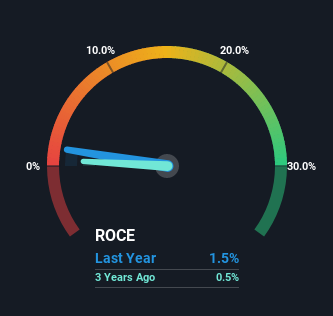VIP Clothing (NSE:VIPCLOTHNG) Could Be Struggling To Allocate Capital

If you're not sure where to start when looking for the next multi-bagger, there are a few key trends you should keep an eye out for. One common approach is to try and find a company with returns on capital employed (ROCE) that are increasing, in conjunction with a growing amount of capital employed. If you see this, it typically means it's a company with a great business model and plenty of profitable reinvestment opportunities. However, after briefly looking over the numbers, we don't think VIP Clothing (NSE:VIPCLOTHNG) has the makings of a multi-bagger going forward, but let's have a look at why that may be.
What is Return On Capital Employed (ROCE)?
For those who don't know, ROCE is a measure of a company's yearly pre-tax profit (its return), relative to the capital employed in the business. To calculate this metric for VIP Clothing, this is the formula:
Return on Capital Employed = Earnings Before Interest and Tax (EBIT) ÷ (Total Assets - Current Liabilities)
0.015 = ₹25m ÷ (₹2.8b - ₹1.2b) (Based on the trailing twelve months to December 2021).
Therefore, VIP Clothing has an ROCE of 1.5%. Ultimately, that's a low return and it under-performs the Luxury industry average of 14%.
View our latest analysis for VIP Clothing

While the past is not representative of the future, it can be helpful to know how a company has performed historically, which is why we have this chart above. If you're interested in investigating VIP Clothing's past further, check out this free graph of past earnings, revenue and cash flow.
What Does the ROCE Trend For VIP Clothing Tell Us?
On the surface, the trend of ROCE at VIP Clothing doesn't inspire confidence. Around five years ago the returns on capital were 6.6%, but since then they've fallen to 1.5%. Although, given both revenue and the amount of assets employed in the business have increased, it could suggest the company is investing in growth, and the extra capital has led to a short-term reduction in ROCE. If these investments prove successful, this can bode very well for long term stock performance.
On a side note, VIP Clothing has done well to pay down its current liabilities to 42% of total assets. So we could link some of this to the decrease in ROCE. What's more, this can reduce some aspects of risk to the business because now the company's suppliers or short-term creditors are funding less of its operations. Some would claim this reduces the business' efficiency at generating ROCE since it is now funding more of the operations with its own money. Keep in mind 42% is still pretty high, so those risks are still somewhat prevalent.
In Conclusion...
Even though returns on capital have fallen in the short term, we find it promising that revenue and capital employed have both increased for VIP Clothing. However, despite the promising trends, the stock has fallen 59% over the last five years, so there might be an opportunity here for astute investors. So we think it'd be worthwhile to look further into this stock given the trends look encouraging.
One more thing: We've identified 5 warning signs with VIP Clothing (at least 2 which shouldn't be ignored) , and understanding them would certainly be useful.
While VIP Clothing may not currently earn the highest returns, we've compiled a list of companies that currently earn more than 25% return on equity. Check out this free list here.
New: Manage All Your Stock Portfolios in One Place
We've created the ultimate portfolio companion for stock investors, and it's free.
• Connect an unlimited number of Portfolios and see your total in one currency
• Be alerted to new Warning Signs or Risks via email or mobile
• Track the Fair Value of your stocks
Have feedback on this article? Concerned about the content? Get in touch with us directly. Alternatively, email editorial-team (at) simplywallst.com.
This article by Simply Wall St is general in nature. We provide commentary based on historical data and analyst forecasts only using an unbiased methodology and our articles are not intended to be financial advice. It does not constitute a recommendation to buy or sell any stock, and does not take account of your objectives, or your financial situation. We aim to bring you long-term focused analysis driven by fundamental data. Note that our analysis may not factor in the latest price-sensitive company announcements or qualitative material. Simply Wall St has no position in any stocks mentioned.
About NSEI:VIPCLOTHNG
VIP Clothing
Engages in the manufacture, marketing, and distribution of garments in India.
Excellent balance sheet very low.
Similar Companies
Market Insights
Community Narratives



